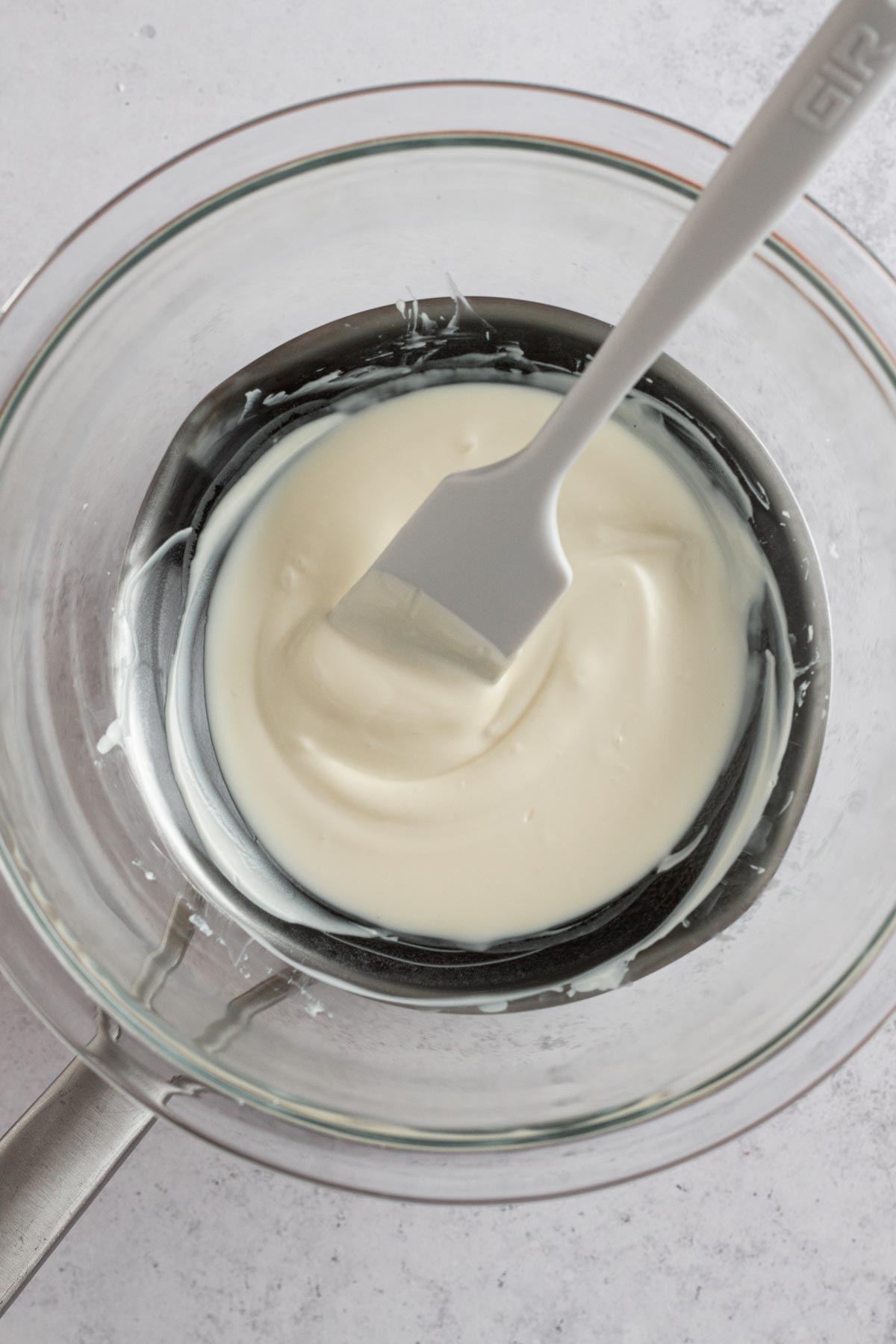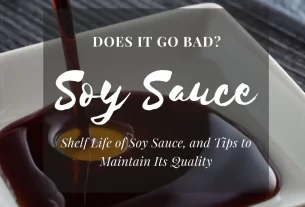Have you ever wondered how to turn those hard, little white chocolate chips into a smooth, melt-in-your-mouth treat?
Look no further!
Whether you’re a dessert enthusiast or a baking novice, learning how to properly melt white chocolate opens up a world of delicious possibilities.
From decadent chocolate-dipped strawberries to beautifully decorated cakes, let’s unlock the secrets to melting white chocolate and take your sweet creations to the next level.
how to melt white chocolate chips
To melt white chocolate chips, it is best to use the double boiler method.
Fill a saucepan with water and place a bowl on top, making sure the bottom of the bowl does not touch the water.
Heat the water to a boil and then reduce it to a gentle simmer.
Stir the white chocolate chips with a rubber spatula as they melt, being careful not to let any water get into the chocolate.
Once fully melted, remove from heat.
Alternatively, you can use the microwave method by placing white chocolate chunks or pieces in a microwave-safe bowl and heating for no more than 20 seconds at a time, stirring after each interval until fully melted.
Avoid overheating or burning the white chocolate.
Key Points:
- Use the double boiler method to melt white chocolate chips.
- Fill a saucepan with water and place a bowl on top, ensuring it doesn’t touch the water.
- Heat the water to a boil and then reduce to a gentle simmer.
- Stir the white chocolate chips as they melt using a rubber spatula, avoiding contact with water.
- Remove from heat once fully melted.
- Alternatively, use the microwave method by heating white chocolate chunks in intervals of 20 seconds, stirring in between until fully melted.
how to melt white chocolate chips – Watch Video
💡
Pro Tips:
1. White chocolate chips are not technically classified as “chocolate” since they do not contain any cocoa solids, but just cocoa butter, sugar, and milk solids.
2. To prevent white chocolate from seizing or becoming grainy when melting, it is crucial to avoid contact with even a single drop of water. Even the smallest amount can cause the chocolate to clump and become unusable.
3. Adding a small amount of vegetable oil or shortening to the white chocolate chips while melting can help make the texture smoother and more pourable, perfect for drizzling or coating.
4. To achieve a velvety smooth consistency when melting white chocolate, it is recommended to use a double boiler or a heatproof bowl placed over a saucepan of simmering water, rather than direct heat. This indirect method helps to prevent scorching or burning the chocolate.
5. When melting white chocolate chips, it is advisable to stir constantly and remove from heat as soon as the last few chunks start to melt. The residual heat will continue to melt the remaining pieces, avoiding overheating and potentially burning the chocolate.
1. Enjoying White Chocolate In Various Ways
White chocolate is a versatile and delicious treat that can be enjoyed in a myriad of ways. From dipping fresh strawberries into its creamy sweetness to drizzling it over freshly baked biscotti, white chocolate adds a touch of elegance and decadence to any dessert. Additionally, it can be used to enhance other desserts, such as adding it to whipped cream for a luscious topping. So whether you are a fan of the traditional white chocolate flavor or looking to jazz up your desserts, white chocolate is the perfect choice.
- Can be enjoyed by dipping fresh strawberries, drizzling over biscotti, and more
- Adds elegance and decadence to any dessert
- Enhances other desserts like whipped cream
- Ideal for traditional or jazzed-up desserts.
2. Understanding The Composition Of White Chocolate
To truly appreciate and understand white chocolate, it’s essential to know its composition. Unlike other types of chocolate, white chocolate does not contain cocoa solids. Instead, it is primarily composed of cocoa butter, milk powder, sugar, and vanilla. Additionally, white chocolate often includes thickeners like soy lecithin to improve its texture.
The combination of these ingredients results in the smooth and creamy texture that white chocolate is known for.
Additional information:
- White chocolate does not have a strong cocoa flavor due to the absence of cocoa solids.
- The cocoa butter used in white chocolate must be of high quality to ensure the best taste and texture.
- Some variations of white chocolate may have added flavors such as fruit or nuts for a unique taste experience.
Remember: True white chocolate should only contain cocoa butter, not vegetable oil substitutes.
- White chocolate is a popular ingredient in desserts, cookies, and confections.
- It also pairs well with fruits and is often used in fruit-based desserts and pastries.
3. The Absence Of Cocoa Solids In White Chocolate
One key distinction between white chocolate and other chocolate varieties is the absence of cocoa solids. While dark chocolate and milk chocolate derive their intense flavors from cocoa solids, white chocolate lacks this component. This absence gives white chocolate its unique flavor profile, characterized by its creamy and delicate taste. So, if you’re looking for a chocolate treat that is less intense and more subtle in flavor, white chocolate is the perfect choice for you.
4. The Temperamental Nature Of Melting White Chocolate
While melting white chocolate may seem like a straightforward task, it can be quite temperamental and easily burned if not done correctly. Due to the high cocoa butter content, white chocolate has a low melting point and can scorch or seize if exposed to high heat. Therefore, it is crucial to melt white chocolate using gentle and indirect heat to avoid any mishaps. By understanding the proper techniques for melting white chocolate, you can achieve a smooth and silky consistency without any burnt or clumpy surprises.
5. Using Indirect Heat To Melt White Chocolate
To ensure the best results when melting white chocolate, it is recommended to use indirect heat. This can be achieved through various methods, such as the double boiler technique or using a microwave. By employing indirect heat, you can control the temperature more effectively and reduce the risk of burning the white chocolate. This gentle approach preserves the delicate flavor and texture of the white chocolate, resulting in a velvety and luscious melted consistency.
- Use indirect heat when melting white chocolate for best results.
- Indirect heat can be achieved through the double boiler technique or using a microwave.
- Controlling the temperature effectively prevents the white chocolate from burning.
- Indirect heat preserves the delicate flavor and texture of the white chocolate, resulting in a velvety and luscious melted consistency.
6. Creating A Double Boiler For Melting White Chocolate
One popular method of melting white chocolate without burning it is by using a double boiler. To create a double boiler:
- Fill a saucepan with water.
- Place a heat-resistant bowl on top of the saucepan, making sure the bottom of the bowl does not touch the water.
- Heat the water in the saucepan to a boil and then turn it down to a gentle simmer.
This setup allows the steam from the boiling water to provide indirect heat, gradually and evenly melting the white chocolate in the bowl above.
It is important to ensure that the bowl and utensils used are completely dry, as even a small amount of water can cause the chocolate to seize.
7. Proper Technique For Melting White Chocolate
When using the double boiler method, it is essential to follow a few techniques to ensure that the white chocolate melts smoothly and evenly.
Begin by stirring the white chocolate with a rubber spatula as it melts, making sure to prevent any water from getting into the chocolate. The water can cause the white chocolate to seize or become grainy.
By stirring constantly and diligently, you can prevent any undesirable texture in the melted white chocolate and achieve the desired smoothness.
- Stir white chocolate with a rubber spatula while it melts
- Avoid getting water into the chocolate
- Constantly stir to prevent seizing or graininess
“By following these techniques, you can achieve perfectly melted and smooth white chocolate.”
8. The Importance Of Stirring While Melting White Chocolate
Stirring is a crucial step in melting white chocolate. It ensures even distribution of heat, avoiding any burned spots. Moreover, stirring helps incorporate any separation that may happen during melting, resulting in a smooth and uniform consistency. To maintain the silky texture of the white chocolate, remember to stir gently and avoid incorporating air bubbles.
9. Removing Melted White Chocolate From Heat
Once the white chocolate has completely melted, it is essential to remove it from the heat source immediately. White chocolate can quickly go from perfectly melted to overcooked and burnt if left on the heat for too long. Therefore, as soon as the white chocolate reaches a smooth and velvety consistency, remove it from the double boiler or turn off the microwave. This step ensures that the white chocolate retains its luscious texture and does not become scorched or clumpy.
10. Alternative Method: Melting White Chocolate In The Microwave
Melting White Chocolate: Alternative Methods
The preferred method for melting white chocolate is the double boiler method. However, there is an alternative approach that involves using a microwave. Here’s how to melt white chocolate in the microwave:
- Place white chocolate chunks or pieces in a microwave-safe bowl.
- Heat the white chocolate on high power for no more than 20 seconds at a time.
- Stir the white chocolate after each 20-second interval.
- This short bursts of heat help to prevent overheating and ensure a smooth melting process.
- Caution: It’s crucial to closely monitor the process to avoid burning or scorching the white chocolate.
Melting white chocolate can be a delicate process that requires careful attention to heat and technique. By using indirect heat, such as the double boiler method or the microwave method, you can achieve a velvety smooth consistency without burning the white chocolate. Don’t forget to stir and promptly remove from heat to ensure the best results. With these tips in mind, you can confidently melt white chocolate chips and explore the delicious possibilities in your culinary creations.
💡
You may need to know these questions about how to melt white chocolate chips
What is the easiest way to melt white chocolate?
When melting white chocolate, the easiest way is to use the microwave method. Start by heating the chocolate in increments of no more than 20 seconds at a time. After each interval, remove the chocolate from the microwave and give it a good stir. This process helps distribute the heat evenly and prevents overheating, as white chocolate is delicate and can burn easily. Repeat this heating and stirring process until the white chocolate is fully melted and smooth, being careful not to exceed the recommended time to avoid burning it.
Can you melt nestle white morsels?
Yes, Nestle White Morsels can be melted. To melt the White Morsels, simply follow the same instructions as for Semi-Sweet Chocolate, Milk Chocolate, Dark Chocolate, or Premier White Morsels. In a microwave-safe bowl, place 1 cup of White Morsels along with 1 tablespoon, then microwave for 45 seconds on high power. Stir the mixture and, if necessary, continue heating for an additional 10-15 seconds, stirring vigorously after each interval until the Morsels are fully melted. Please note that microwaves vary, so it is important to adjust the heating time as needed.
What is the best way to melt white chocolate for dipping?
To melt white chocolate for dipping, the double boiler method is highly recommended. Begin by filling a saucepan with a small amount of water and bringing it to a simmer. Then, place a heat-safe mixing bowl on top of the saucepan, making sure it fits snugly. Add the white chocolate to the mixing bowl and turn the stove to medium heat. As the water simmers and releases steam, the steam will gently heat the chocolate, causing it to melt smoothly and evenly. This method ensures that the chocolate maintains its quality and avoids any risk of burning or seizing.
Why won t my white chocolate chips melt?
White chocolate chips not melting could be attributed to the delicacy of white chocolate. Due to its sensitivity, even the slightest introduction of steam or water into the melting process can cause the chocolate to seize. Additionally, overcooking white chocolate can also result in it not melting properly. As a result, these factors may explain why your white chocolate chips are refusing to melt.
Reference source
https://www.thekitchn.com/how-to-melt-white-chocolate-23436632
https://www.marthastewart.com/8180373/how-melt-white-chocolate
https://www.youtube.com/watch?v=tUZicl_IxOg
https://www.verybestbaking.com/toll-house/baking-101/melting-tips/



